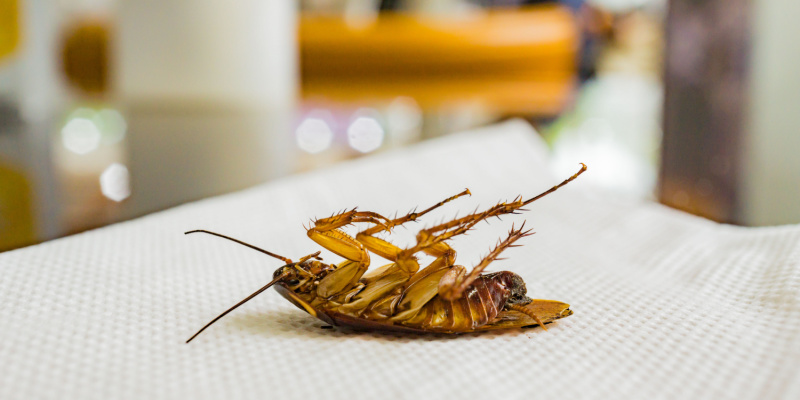Top 5 Signs You Have a Serious Cockroach Problem in Your Restaurant

Cockroaches are not just a minor nuisance; they can signify deeper cleanliness and structural issues in a restaurant, posing serious health risks to customers and potentially jeopardizing your business. Recognizing the signs of a serious cockroach infestation is crucial for taking timely action. Here are the top 5 indicators that your restaurant may be facing a significant cockroach problem: 1. Visible Cockroaches During the Day Cockroaches are nocturnal creatures, so seeing them during the day is a strong indication of a large population. If cockroaches are competing for food and space, they will venture out at unusual times. Spotting them regularly, especially in food preparation or storage areas, signals an urgent need for pest control intervention. 2. Cockroach Droppings Cockroach droppings resemble black pepper or coffee grounds and can be found where cockroaches are active. The presence of droppings in drawers, shelves, and countertops, or along walls and baseboards, is a telltale sign of an infestation. Teach your staff to look out for this sign of cockroach activity. It is easy to brush the cockroach droppings off as a spill instead of realizing that they are a sign of pest activity. Larger roaches might produce cylindrical droppings, which can indicate the type of cockroach and the size of the problem. 3. Egg Cases and Shed Skins Cockroaches shed their exoskeletons multiple times throughout their lifecycle. Finding shed skins or egg cases, which are dark-colored and oblong, around your restaurant indicates a breeding population. Check in hidden areas, like under appliances and in corners, for these signs of reproduction and growth. 4. Foul Odor A significant cockroach infestation can produce a musty, unpleasant smell. This odor comes from pheromones released by the cockroaches and can permeate food and surfaces in the restaurant. If customers or staff notice a persistent foul smell, it could be due to a large cockroach presence. 5. Damage to Food and Packaging Cockroaches are voracious eaters that can chew through cardboard, paper, and plastic to access food. Finding holes in food packaging, gnawed on fruits and vegetables, or compromised dry goods are clear indicators of a cockroach infestation. This not only leads to food waste but also poses serious health risks. The Importance of Professional Pest Control Recognizing these signs early can save your restaurant from further damage and health hazards. Cockroaches are resilient pests that require professional expertise to eliminate effectively. Systematic Pest Elimination offers comprehensive pest control services that address the root of the problem, employing state-of-the-art techniques and solutions to ensure your restaurant is cockroach-free. Systematic Approach to Cockroach Elimination Our approach includes: A serious cockroach problem in your restaurant is not to be taken lightly. It can impact your reputation, customer satisfaction, and ultimately, your bottom line. Recognizing the signs of an infestation is the first step towards addressing the issue. Partnering with a professional pest control service like Systematic Pest Elimination ensures that your establishment remains a clean, safe, and welcoming environment for both staff and patrons.
Are Landlords or Tenants Responsible for Pest Control in NYC?

Pest infestations are an unfortunate reality in urban environments like New York City. In a densely populated city where apartment living is standard, disputes over pest elimination responsibilities can be a source of contention between landlords and tenants. Understanding who is responsible for pest mangement in NYC is crucial for both parties to maintain a harmonious and pest-free living environment. Landlord’s Responsibility In New York City, landlords have specific legal responsibilities regarding pests. These responsibilities are outlined in the city’s housing code, and they primarily revolve around providing tenants with a habitable and pest-free living space. 1. Initial Pest Treatment Landlords are typically responsible for addressing pest infestations when a tenant first moves in. They must ensure that the rental unit is free of pests, including common nuisances like rodents, cockroaches, and bedbugs. This initial treatment is a crucial part of the landlord’s responsibility to provide a habitable living environment. 2. Taking Action on Tenant Complaints If a tenant reports a pest infestation, the landlord is generally responsible for addressing the issue promptly and effectively. This includes hiring professional pest elimination services if necessary. 3. Regular Extermination Beyond the initial treatment, landlords are generally expected to maintain a pest-free environment throughout the duration of the tenant’s occupancy. This includes routine pest maintenance, such as inspections and treatments, to prevent infestations from occurring or worsening. Regular maintenance can vary depending on the building and its history of pest issues. 4. Addressing Common Areas Landlords are responsible for pest prevention in common areas of apartment buildings. This includes lobbies, hallways, basements, and any shared spaces where pests might thrive. Ensuring that these areas are pest-free is essential for the well-being of all tenants. 5. Compliance with the Housing Maintenance Code Landlords must comply with the New York City Housing Maintenance Code, which includes provisions related to pest prevention and maintenance standards. 6. Pest Disclosure Before a new tenant moves in, landlords are often required to disclose any known pest infestations or treatments that have occurred in the past year. Tenant’s Responsibility While landlords have a significant role in pest elimination, tenants also bear certain responsibilities to maintain a pest-free living environment. Tenants are responsible for keeping their rental units clean and practicing proper food storage and disposal. Crumbs, food scraps, and unsealed food containers can attract pests like rodents and cockroaches. Tenants should regularly clean their living spaces, sweep up crumbs, and store food in sealed containers to minimize the risk of infestations. Tenants should promptly report any signs of pests to their landlords. This includes sightings of pests, evidence of infestations, or suspected pest-related problems. Timely reporting allows landlords to address issues before they worsen. When landlords arrange for pest management treatments, tenants are expected to cooperate with the process. This may include preparing the unit by removing clutter, emptying cabinets, and following any specific instructions provided by the pest elimination professionals. Cooperation is essential for the effectiveness of pest treatments. Tenants can take preventative measures to minimize the risk of pest infestations. This includes using caution when acquiring used furniture or belongings, as these items can introduce pests into the home. Disputes and Legal Recourse In situations where there is a dispute between a landlord and a tenant regarding pest prevention responsibilities, it’s advisable to consult the lease agreement. Lease agreements can vary, and some may specify additional terms related to pest responsibilities. If an agreement cannot be reached and the issue persists, tenants have legal options to ensure their rights are protected. Tenants can file a complaint with the New York City Department of Housing Preservation and Development (HPD) to request an inspection and enforce pest removal requirements. In severe cases, tenants may also consider seeking legal counsel or mediation to resolve disputes. In summary, the responsibility for pest elimination in NYC is a shared one, with both landlords and tenants playing crucial roles. Landlords must ensure that their rental units are pest-free when tenants move in and provide ongoing maintenance and treatment in common areas. Tenants, on the other hand, are responsible for maintaining cleanliness in their units, reporting pest issues promptly, and cooperating with pest elimination experts such as Systematic Pest Elimination. While the housing code in NYC outlines these responsibilities, lease agreements may provide additional details, so both landlords and tenants need to understand their respective roles. In situations where disputes arise, it’s advisable to seek resolution through legal channels or mediation to ensure a fair and pest-free living environment for all parties involved. Ultimately, a cooperative approach between landlords and tenants is critical to maintaining a pest-free and harmonious rental community in New York City.
